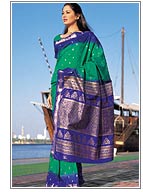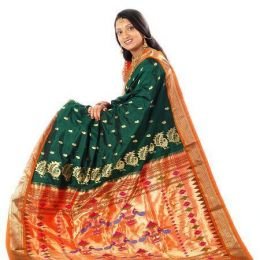Paithani Sarees
 Paithani sarees are the famous traditional silk sarees of Maharashtra. A
hand-woven sari in gorgeous colours and intricate designs, a paithani saree
is treasured as a valuable possession in every Maharashtrian family.
Paithani saree is named after the Paithan town in Aurangabad Maharashtra
state where the saree is woven by hand. No Maharashtrian wedding trousseau
is complete without the Paithani sari. Paithani Saris give a very elegant
look with royalty and style. Teamed up with the appropriate accessories,
these saris add enormous grace and beauty.
Paithani sarees are the famous traditional silk sarees of Maharashtra. A
hand-woven sari in gorgeous colours and intricate designs, a paithani saree
is treasured as a valuable possession in every Maharashtrian family.
Paithani saree is named after the Paithan town in Aurangabad Maharashtra
state where the saree is woven by hand. No Maharashtrian wedding trousseau
is complete without the Paithani sari. Paithani Saris give a very elegant
look with royalty and style. Teamed up with the appropriate accessories,
these saris add enormous grace and beauty.
Fabric in Paithani Sarees
The Paithani sarees are made of silk in rich, vivid colors with gold embroidery. In the modern Paithani sarees, silver threads coated with gold are used instead of pure gold threads. It takes time to create a paithani saree, ranging from a month to years and hence the saree is expensive. The reason for taking such a long time is that the preparation process evolves from a cotton base to a silk base. While cotton is used in the body of the fabric, silk is used in designs and in the borders.Designs and Motifs in Paithani Sarees
Paithani saris are known for their distinctive intricate weaving in pure silk and gold. The paithani sari has played a meaningful role in weaving together the cultural fabric of Maharashtra. These sarees are considered as one of the richest saris in Maharashtra. The Paithani sari is known the world over for its uniqueness. It is one of the most beautiful saris in the world. It’s beautifully crafted, with an exquisite zari border.Distinctive motifs are woven into the sari. The zari used in the preparation of the Paithani sari is specially procured from Surat in Gujarat. The designs available in the border and pallus are like mor (peacock), tara (star), kuyri (mango), popat (parrot), paisa (coin), pankha (fan), rui phool (flower), kamal (lotus), chandrakor (moon), kalas pakli (petal), narli (coconut) and so on. Many of these designs are found on the border and pallu in different sizes and patterns. In the pallu, the base is in gold and the pattern is done in silk, giving the whole sari an embossed look. Paithani sarees are generally decorated with the gold dot or coin motif. The specialty of the paithani is its border and pallav. The Paithani silk saris are one of the richest gold brocade saris with stunning gold patterns woven in them.

Paithani Saree
Paithani Sarees Colours
These sarees have a special dhoop-chaav (light and shade) effect which is achieved by bringing two different coloured silk threads together in the process of a simple tabby weave. These sarees are available in plain as well as spotted designs. Among other varieties, single colored and kaleidoscope-colored designs in the Paithani sarees are also popular. The kaleidoscopic effect is produced by using one color for weaving lengthwise and another for weaving widthwise. The shades vary from vivid magenta, peacock greens and purples. The dominant traditional colours of vegetable dyes included blue, red and green, black and white, black and red, pink, purplish red and yellow.Classification of Paithani Saree
For anyone who is interested in buying a paithani saree, the following classifications will be helpful. Paithani Sarees can be classified in three ways:Classification by motif
Here the popular motifs are Bangadi Mor, Munia brocade and the lotus. The word "bangadi" means bangle and "mor" means peacock. So bangadi mor means a peacock in a bangle or in a bangle shape. Munia means parrot. Parrots are woven on the pallu as well as in border of the saree and are in leaf green colour. Lotus motifs in 7-8 colours are used in pallu.Classification by weaving
There are two ways of weaving the saree. The Kadiyal border Saree in which the warp and the weft of the border are of the same colour while the body has different colours for warp and weft. The other weaving technique is the Kad/Ekdhoti, where a single shuttle is used for weaving of weft. The colour of the warp yarn is different from that of the weft yarn.Classification by colour
- Raghu: Parrot green coloured Saree.
- Kalichandrakala: It is a pure black Saree with red border.
- Shirodak: It is a pure white Saree.
Popularity of Paithani Sarees Worldwide
These saree are not only acclaimed in India but also have a large number of admirers in other countries as well. Most artists describe a paithani saree as a poem hand woven in silk and gold. These sarees are most sought after by all those with discerning and refined taste. Even in today's advanced world, the methods of weaving Paithani have not changed at all and this saree can cost anywhere between R. 6000 to Rs. 500, 000. The saree is also considered holy in Indian tradition. The paithani saree is indeed a legacy of art and is the glory of Maharashtra.